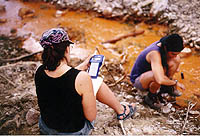
November 6, 2000
Inoperative mercury mines fingered as a major source of mercury contamination in California waters
By Tim Stephens
 |
| UCSC researchers collected water quality data at San Carlos Creek, which flows past the inoperative New Idria mercury mine. Photo courtesy of Environmental Toxicology Department |
The mercury appears to be coming not from the mine tunnels but from the extensive piles of mine tailings on the site, said Priya Ganguli, lead author of the study, which was published in the current issue of the journal Environmental Science and Technology. Ganguli, who performed the research as a graduate student at UCSC, is currently an environmental specialist with the San Francisco Regional Water Quality Control Board.
The findings have implications far beyond New Idria, said Russell Flegal, professor and chair of environmental toxicology and a coauthor of the study. Preliminary results from other mine sites indicate that inoperative mercury mines are a major source of mercury pollution in bodies of water such as San Francisco Bay that consistently exceed water quality standards for the toxic element, Flegal said. Methylmercury, the most hazardous form of the element, is a potent neurotoxin that has begun to get increased scrutiny from health scientists and regulatory agencies.
"Methylmercury is dangerous because it enters the food chain and accumulates in fish, which can end up having concentrations of mercury in their tissues a million times higher than in the surrounding water," Flegal said.
State health officials have issued fish consumption advisories due to mercury pollution for more than a dozen bodies of water in California, including San Francisco Bay and several areas in the Coast Ranges.
At the New Idria site, San Carlos Creek is stained bright orange from iron oxides carried in acidic water that drains out of the mine. The creek flows northward, ultimately draining to an area near the Mendota Wildlife Refuge at the headwaters of the San Joaquin River. Ganguli analyzed mercury concentrations in the acid mine drainage as well as in samples collected from the creek upstream and downstream from the mine. The researchers measured total mercury concentrations, as well as the concentrations of specific forms of mercury, including methylmercury and elemental mercury.
"Total mercury concentrations in the acid mine drainage were comparable to concentrations upstream from the mine, but downstream from the mine there were much higher concentrations," Ganguli said. "Based on where the highest concentrations are, we think the primary source of the mercury is runoff from the mine waste piles alongside the creek."
At New Idria and other California mercury mines, the mercury was extracted from cinnabar ore in a process called calcination. This involved crushing the ore and roasting it to release elemental mercury, leaving behind waste rock known as calcine. Invariably, the calcine waste still contains some soluble mercury that may leach into surface water and flow into the creek, Ganguli said. Certain types of bacteria convert elemental mercury (the silvery liquid metal used in thermometers) into methylmercury, although the conversion can also occur without microbial activity.
The researchers calculated a conservative estimate of 1.5 kilograms (a little over 3 pounds) of mercury entering San Carlos Creek from the New Idria mine each year. But Ganguli noted that this is a baseline figure that does not account for potentially large inputs during heavy rains. The annual mercury load from the mine site could be more than ten times higher than this preliminary estimate, she said.
An important question not answered by this study is how far the mercury travels downstream from the mine. Studies in other locations have shown that metals from acid mine drainage can travel hundreds of miles downstream from their source, so it is possible that some of the mercury from the New Idria mine flows down the San Joaquin River into San Francisco Bay. But Ganguli said the amount that gets to the bay is probably insignificant compared to mercury inputs from sources much closer to the bay, such as the New Almaden mine in the Santa Cruz Mountains near San Jose.
Substantial amounts of mercury are entering the Guadalupe River from the New Almaden mercury mine, according to Khalil Abu-Saba, a coauthor of the New Idria paper and, like Ganguli, a former graduate student in Flegal's lab and now an environmental specialist for the Regional Water Quality Control Board. Abu-Saba, who is working on regulations to control mercury pollution in San Francisco Bay, said he is convinced that the New Almaden mine is the biggest ongoing source of mercury in the bay.
In addition to Ganguli, Abu-Saba, and Flegal, the paper's authors include Robert Anderson, professor of Earth sciences, and Robert Mason from the Center for Environmental Studies at the University of Maryland.